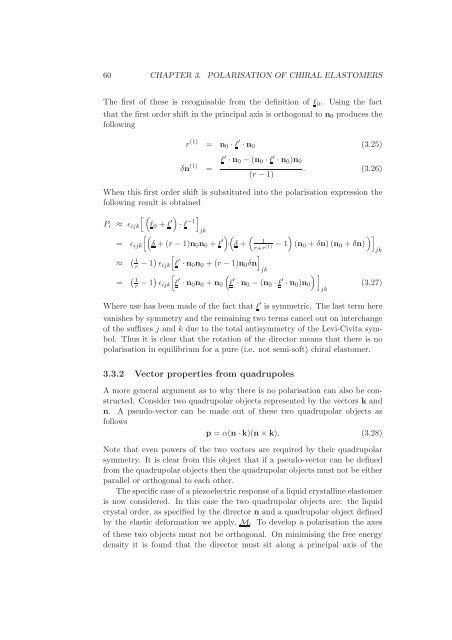Statistical models of elasticity in main chain and smectic liquid ...
Statistical models of elasticity in main chain and smectic liquid ...
Statistical models of elasticity in main chain and smectic liquid ...
Create successful ePaper yourself
Turn your PDF publications into a flip-book with our unique Google optimized e-Paper software.
60 CHAPTER 3. POLARISATION OF CHIRAL ELASTOMERSThe first <strong>of</strong> these is recognisable from the def<strong>in</strong>ition <strong>of</strong> l 0 . Us<strong>in</strong>g the factthat the first order shift <strong>in</strong> the pr<strong>in</strong>cipal axis is orthogonal to n 0 produces thefollow<strong>in</strong>gr (1) = n 0 ·l ′ ·n 0 (3.25)δn (1) =l ′ ·n 0 −(n 0 ·l ′ ·n 0 )n 0(r −1). (3.26)When this first order shift is substituted <strong>in</strong>to the polarisation expression thefollow<strong>in</strong>g result is obta<strong>in</strong>ed[(P i ≈ ǫ ijk l 0 +l ′)·l −1] jk= ǫ ijk[(δ +(r −1)n 0 n 0 +l ′)·(δ +(1≈ ( ]1r −1) ǫ ijk[l ′ ·n 0 n 0 +(r −1)n 0 δnr+r (1) −1= ( 1r −1) ǫ ijk[l ′ ·n 0 n 0 +n 0(l ′ ·n 0 −(n 0 ·l ′ ·n 0 )n 0)]jk))](n 0 +δn)(n 0 +δn)jkjk(3.27)Where use has been made <strong>of</strong> the fact that l ′ is symmetric. The last term herevanishes by symmetry <strong>and</strong> the rema<strong>in</strong><strong>in</strong>g two terms cancel out on <strong>in</strong>terchange<strong>of</strong> the suffixes j <strong>and</strong> k due to the total antisymmetry <strong>of</strong> the Levi-Civita symbol.Thus it is clear that the rotation <strong>of</strong> the director means that there is nopolarisation <strong>in</strong> equilibrium for a pure (i.e. not semi-s<strong>of</strong>t) chiral elastomer.3.3.2 Vector properties from quadrupolesA more general argument as to why there is no polarisation can also be constructed.Consider two quadrupolar objects represented by the vectors k <strong>and</strong>n. A pseudo-vector can be made out <strong>of</strong> these two quadrupolar objects asfollowsp = α(n·k)(n×k). (3.28)Note that even powers <strong>of</strong> the two vectors are required by their quadrupolarsymmetry. It is clear from this object that if a pseudo-vector can be def<strong>in</strong>edfrom the quadrupolar objects then the quadrupolar objects must not be eitherparallel or orthogonal to each other.Thespecificcase <strong>of</strong>apiezoelectric response<strong>of</strong>a<strong>liquid</strong>crystall<strong>in</strong>eelastomeris now considered. In this case the two quadrupolar objects are: the <strong>liquid</strong>crystal order, as specified by the director n <strong>and</strong> a quadrupolar object def<strong>in</strong>edby the elastic deformation we apply, M. To develop a polarisation the axes<strong>of</strong> these two objects must not be orthogonal. On m<strong>in</strong>imis<strong>in</strong>g the free energydensity it is found that the director must sit along a pr<strong>in</strong>cipal axis <strong>of</strong> the
















